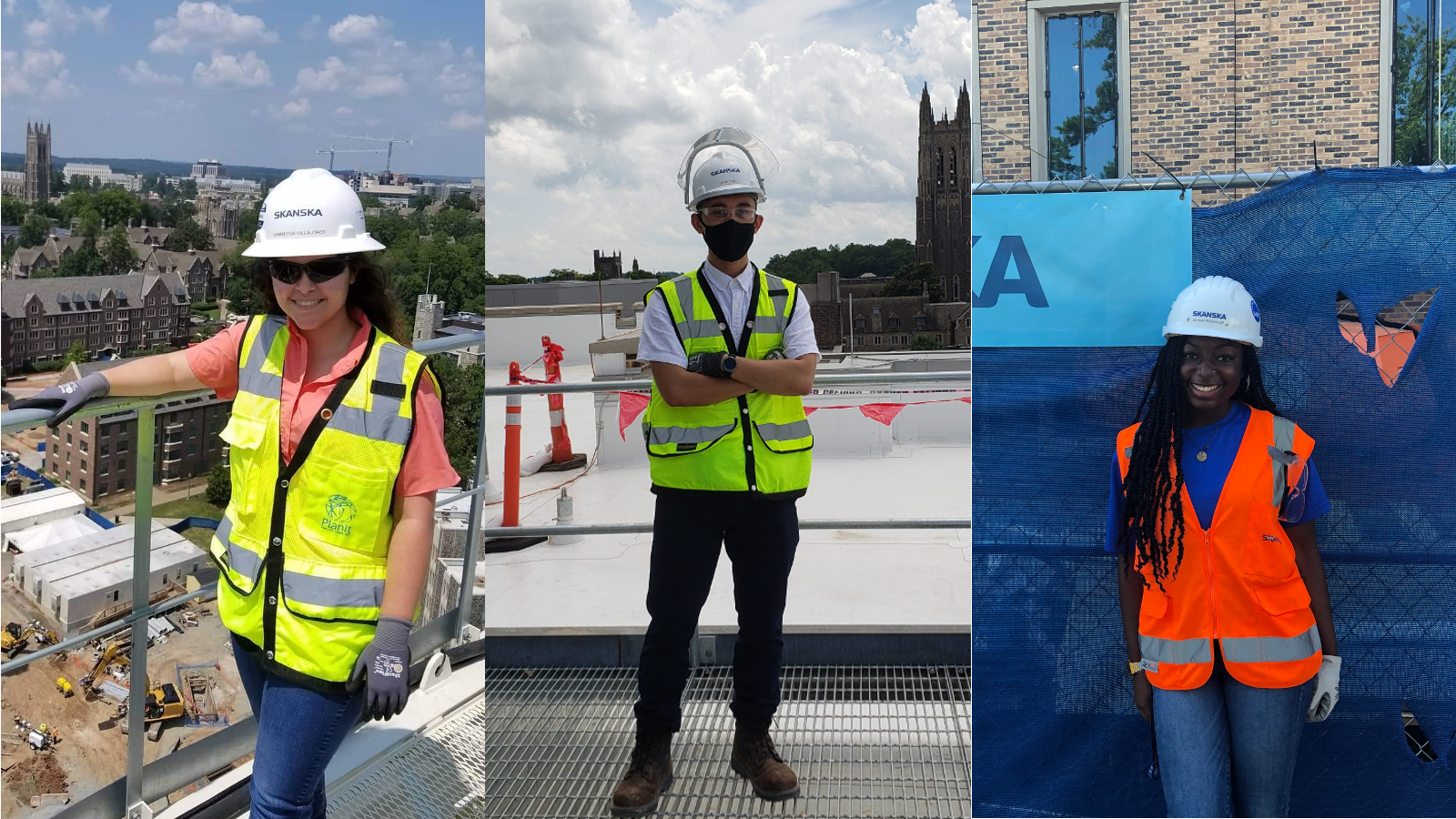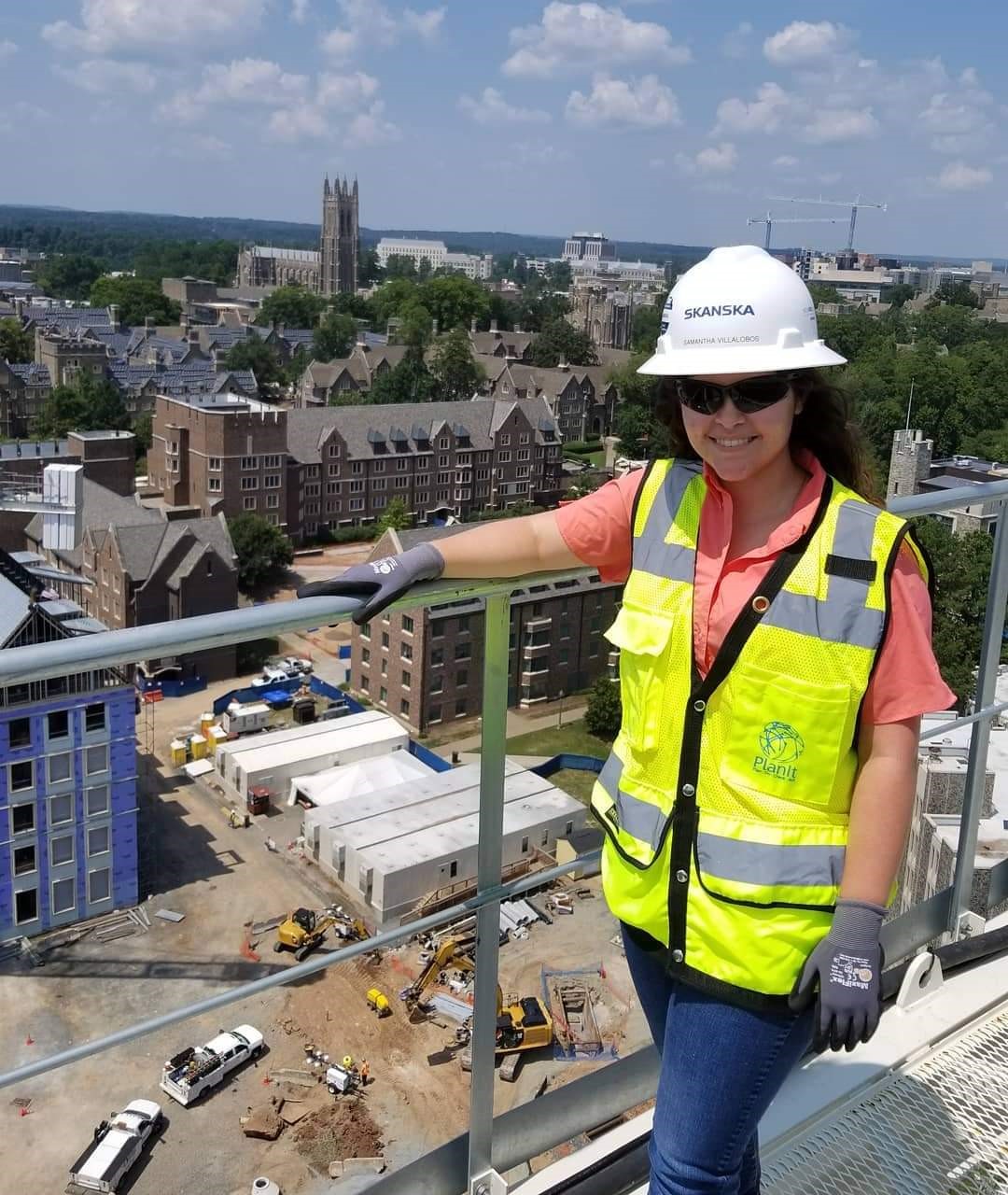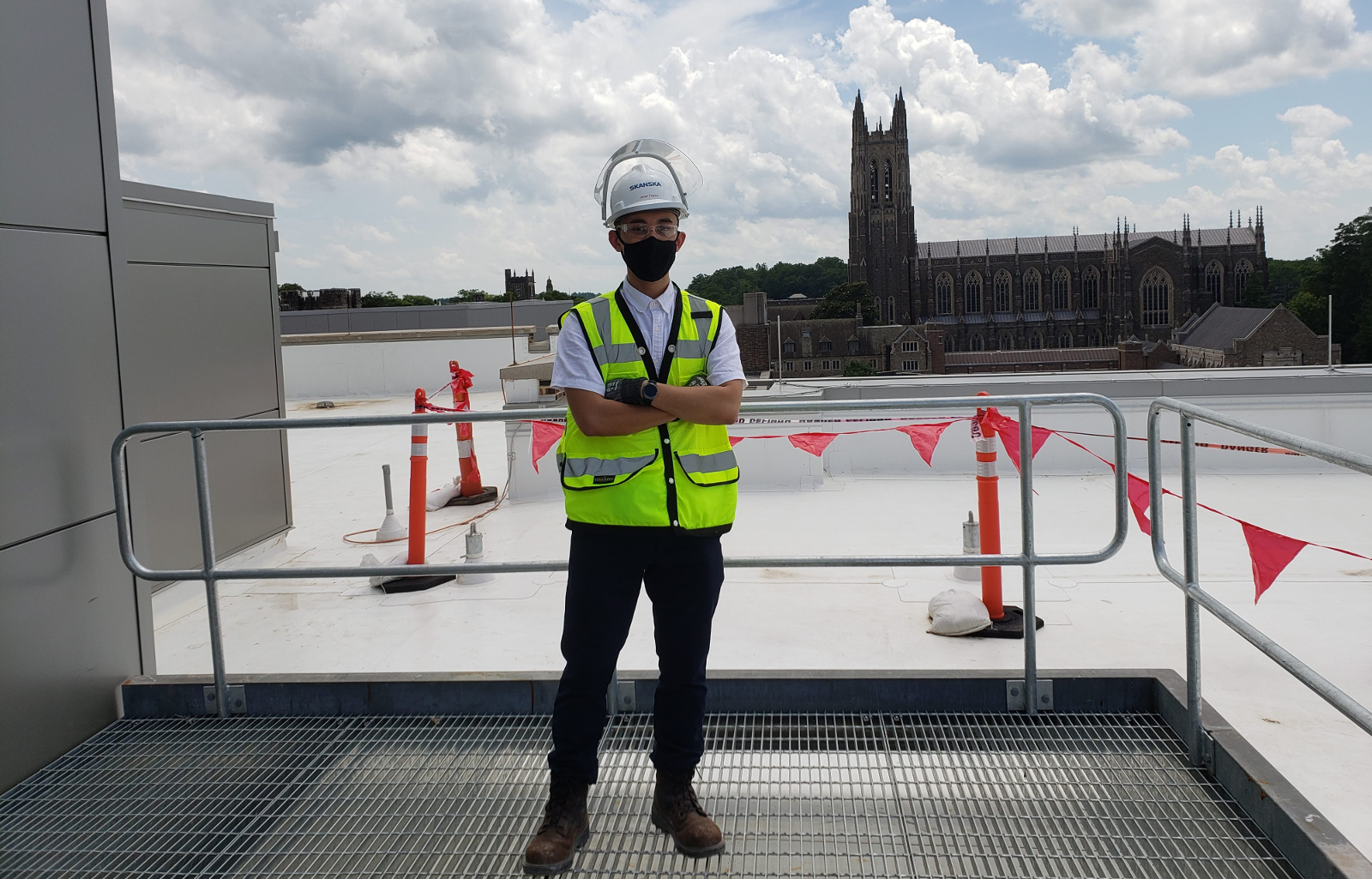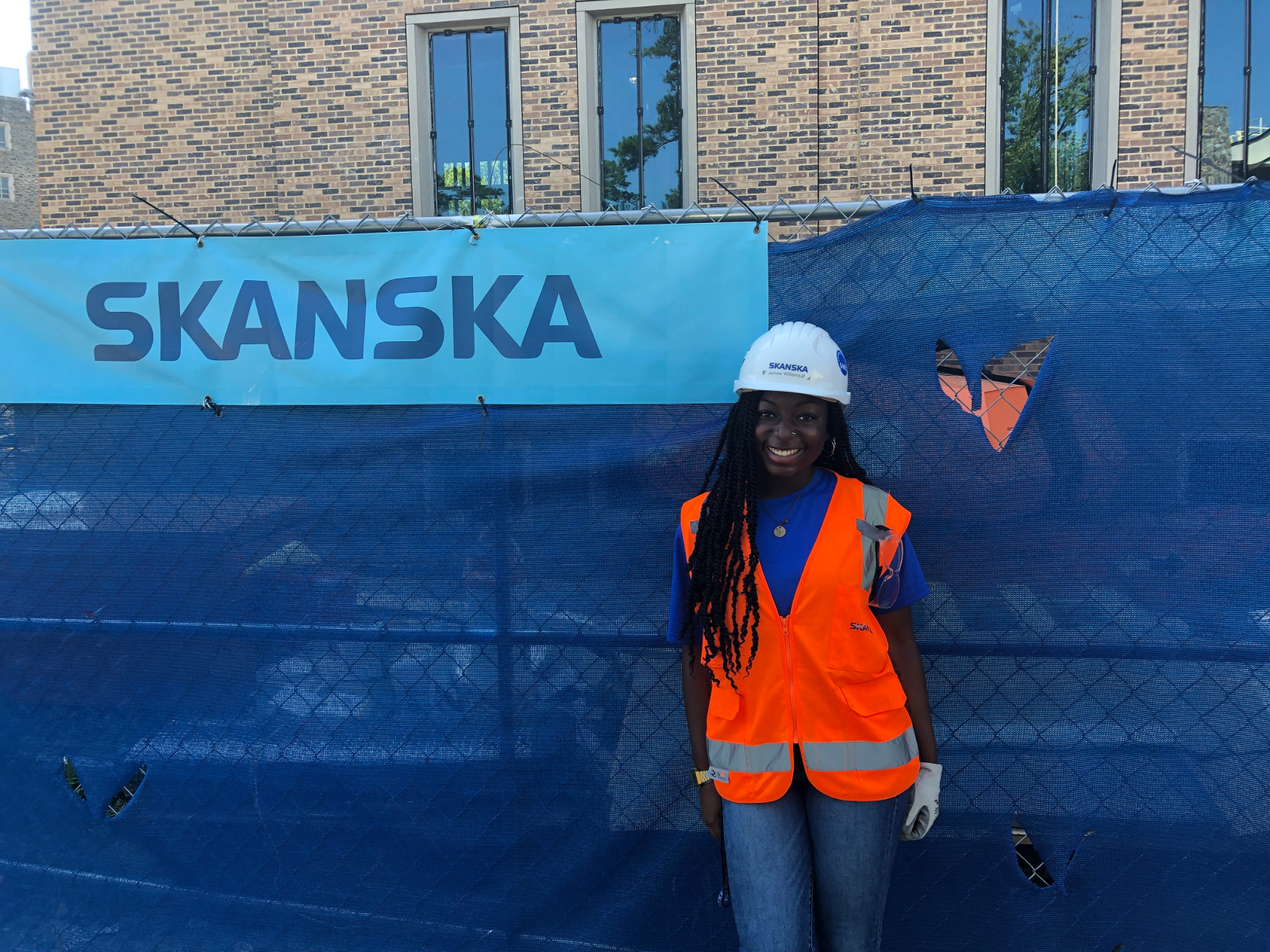Construction Transforms Campus—and Students
By Ken Kingery
Three Duke Engineering undergraduates gained real-world engineering experience—and helped make the Wilkinson Building a reality—as Skanska interns

Long before the Wilkinson Building opened its doors for classes this semester, it was already advancing hands-on engineering education—at least for three Duke Engineering students chosen for internships with the Skanska construction team.
“I was a civil engineering major my entire career, but for the longest time I didn’t know what I wanted to do after graduation,” said Sam Villalobos, who graduated in 2019 with certificates in Latino studies and architecture added to her engineering degree. “Construction was not something I had ever considered, I think because of industry stereotypes, but after an information session with Skanska I decided to apply anyway.”
The first of the trio of interns, Villalobos got the job and spent the summer of 2018 creating a time-oriented 3D model of the Wilkinson Building’s construction plan, handling requests for information forms, working with subcontractors to make sure specifications were being met, and more. Next she got another internship doing similar work for the new Hollows Quad residence hall. And after graduation, she replaced the title “intern” with “preconstruction engineer,” accepting a full-time position in Skanska’s Durham office.
“There were just a lot of people I connected with on the field team and I felt supported there, especially as a woman working in a male-dominated field,” said Villalobos. “More young people should give it a chance. My experiences have greatly helped me in my career, and Skanska is constantly working to bring new technology into the field. It’s a very innovative time in the industry.”
Her experience is not unique, nor is it by accident.
 “Interns are the future of our business and it is a great way to recruit and hire young talent,” said Paul Kelker, senior project manager for Skanska in Durham. “I started with Skanska as an intern and we often hire our interns after graduation. I feel students experience a firsthand ‘boots in the field’ and real-world view of our industry. We assign our interns with real-time project challenges and provide the tools and supervision to allow them to solve problems and create solutions.”
“Interns are the future of our business and it is a great way to recruit and hire young talent,” said Paul Kelker, senior project manager for Skanska in Durham. “I started with Skanska as an intern and we often hire our interns after graduation. I feel students experience a firsthand ‘boots in the field’ and real-world view of our industry. We assign our interns with real-time project challenges and provide the tools and supervision to allow them to solve problems and create solutions.”
“Skanska has been a great local and national partner with Duke for more than a decade, providing students with experiential opportunities, advising for student organizations and participating in career preparation and mentoring programs,” echoed Kirsten Shaw, director of corporate and industry relations at Duke Engineering. “We enjoy strong support from our alumni at Skanska, and Duke students benefit from their willingness to continue to engage with Duke to help educate and train the next generation of engineers.”
Enthusiastic about her experience, Villalobos convinced K-Ville co-tenter Javier Franco to apply for the same internship working on the Wilkinson Building during the summer of 2020. Now a mechanical engineering junior with a minor in energy engineering, Franco also hadn’t pictured himself on the construction path before the internship.
But now he’s not so sure. Even with a design internship lined up with Boeing next summer—more in line with what he’s always envisioned for his career—he hasn’t ruled out a future in the construction industry.
Similar to Villalobos, Franco spent a summer working on the Wilkinson Building with the Skanska mechanical, electrical, plumbing (MEP) team, making sure the subcontractors were communicating with the design team and following their specifications, and that construction was progressing on schedule.
Unlike Villalobos, he had to deal with the pandemic.
 “COVID canceled a lot of my plans and moved classes online, so I was grateful to still have this opportunity to do something in person and see the product of my work,” said Franco. “On a construction site, there’s already so many safety requirements to follow and equipment to wear, so masks and social distancing were just one more aspect. People did a great job with the new requirements and I felt safe being out on the job.”
“COVID canceled a lot of my plans and moved classes online, so I was grateful to still have this opportunity to do something in person and see the product of my work,” said Franco. “On a construction site, there’s already so many safety requirements to follow and equipment to wear, so masks and social distancing were just one more aspect. People did a great job with the new requirements and I felt safe being out on the job.”
Between Villalobos’s and Franco’s time in the internship role, it was filled by Jamiee Williams, a current senior in civil engineering with a focus on structures and a certificate in architectural engineering. Working during a different phase of the building’s construction, she had a similar but slightly different role to play with the MEP team. This included daily site walks for safety and quality, project meetings with team members, creating simplified drawings for the subcontractors to use, learning and teaching Procore project management software, and more.
“This experience definitely gave me more clarity on what I want to achieve in my future,” said Williams. “After graduation, I plan to rest for a bit and then tackle a full-time position at a construction, civil consulting or engineering firm.”
Besides providing more clarity on her career ambitions, Williams said her experience at Skanska also helped her gain more insight on how construction impacts individuals, whether or not the building was built for them. With the Wilkinson Building, for example, the facility will impact the students, specifically the engineering ones, by allowing more access to each other through its collaborative spaces, and to professors with its centralized location of offices and labs. But the building also may assist in the provision of jobs, as most newly constructed spaces.
“It’s more than just a building,” said Williams. “Construction impacts the environment, the individuals building it, the individuals maintaining it, the individuals using it and much more.”
For example, Williams cites the Wilkinson’s Building courtyard as a simple but probably overlooked feature of the new building. Bordering the Bostock Library and not too far from the Old Chemistry Building nor the Duke Hospital, the Wilkinson Building is able to bridge the gap between Trinity and Pratt.
 “More often than not, Pratt students are very isolated. Our classes all reside in two or three engineering buildings, which all are in the back corner of West Campus,” said Williams. “The courtyard encourages a bridge, as it offers a space for everyone to relax, study or speak with friends. It is also a very open space, which usually is a component that invites people in. Something as ‘simple’ as an additional courtyard space or the location of a building can really influence the program!”
“More often than not, Pratt students are very isolated. Our classes all reside in two or three engineering buildings, which all are in the back corner of West Campus,” said Williams. “The courtyard encourages a bridge, as it offers a space for everyone to relax, study or speak with friends. It is also a very open space, which usually is a component that invites people in. Something as ‘simple’ as an additional courtyard space or the location of a building can really influence the program!”
Beyond the obvious—and less obvious—impacts the Wilkinson Building holds for Duke Engineering, all three former Skanska interns agree that their roles in building it shaped their career ambitions and that there’s a great value to be gained by working in the field.
“The experience taught me that if don’t know something, to ask questions,” said Franco. “There’s so much that goes into any large project, and picking the brains of people with years and years of experience in the industry is the best way to learn. That’s an approach I’ll be taking when working with airplanes as well.”
They also agree that the Wilkinson Building will be transformational for Duke engineering students for decades to come, and they’re proud to have played a part in its construction.
“The terrace at the top of the building has a perfect view of the chapel, and it’s just a really nice place with natural light that students will enjoy studying in,” said Villalobos. “One of the coolest parts about construction, in general, is getting to see the tangible results of what you’ve worked on. I have friends who live in the Hollows and who will now take classes in the Wilkinson Building. Seeing all of these great new spaces reminds me of where I started and makes me feel very proud.”
